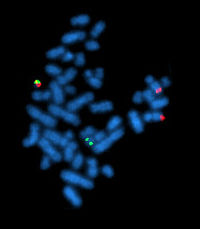
Photo from wikipedia
The lack of an association between altered international normalized ratio (INR) and the risk of bleeding in patients with chronic liver disease is not novel, and studies dating back to… Click to show full abstract
The lack of an association between altered international normalized ratio (INR) and the risk of bleeding in patients with chronic liver disease is not novel, and studies dating back to the 1980s already demonstrated that bleeding following invasive procedures was unrelated to the prothrombin time/INR, or to the platelet count.1 Despite this evident lack of association, which was repeatedly confirmed through the decades in different settings, the tendency to correct INR values before procedures in patients with chronic liver disease persisted in spite of the evidence that plasma supplementation was rarely efficacious and often detrimental due to volume expansion leading to abrupt increases in portal pressure.2,3 Indeed, recent guidelines of the main international gastroenterological, hepatological, and hemostasis scientific societies strongly discouraged the correction of INR before invasive procedures due to the absence of a correlation between INR values and the risk of postprocedural bleeding.4– 8 However, these guidelines are not necessarily adopted in daytoday clinical practice. Recent surveys showed that many clinicians in fact do use the INR to predict bleeding risk and that correction of the INR with the aim of reducing bleeding risk is still common.9,10 Amidst this undisputed reality, one might wonder why we should still need the results obtained in the study by Afzal and colleagues, published in this issue of the Journal of Thrombosis and Haemostasis, to put a final “nail in the coffin” of the inappropriate use of the INR to predict bleeding in patients with chronic liver disease.11 As a fact, the study by Afzal and colleagues leads us back to the roots of the appropriate use of INR as a laboratory aid to determine the intensity of vitamin K antagonist (VKA) treatment and to assess the potential bleeding risk associated with VKA use, while demonstrating how its use as a tool to assess bleeding risk in patients with chronic liver disease is inappropriate.11– 14 Indeed, this study adds to the current body of knowledge showing, in a clinical setting, what has already been well documented in preclinical studies reporting how using INR to predict bleeding in patients with chronic liver disease explores just one side of the moon — it does not consider the counterbalancing decrease in anticoagulant factors synthesized by the liver, such as protein C and antithrombin.15 The study by Afzal and colleagues — carried out in a population of more than 80 000 US veterans — clearly demonstrates that increasing INR values are not associated with an increasing risk of spontaneous or procedurerelated bleeding in patients with chronic liver disease; however, they do confirm this association in patients using warfarin. In patients with chronic liver disease, an INR value above 1.5 was associated with a twofold increase in the risk of bleeding compared with patients with INR values below this threshold, but with increasing INR values no further increase in bleeding risk was observed. Low albumin levels and elevated bilirubin were independent contributors to the risk of bleeding in these patients, highlighting how the increased bleeding risk observed above the 1.5 INR threshold was mainly related to features of advanced liver disease. This observation is supported by the evidence that half of the bleeds were nonvariceal upper gastrointestinal bleeds, which may not be related to haemostatic failure, but could be a consequence of portal hypertension. Thus, although advancing liver disease is associated with an increased bleeding
Journal Title: Journal of Thrombosis and Haemostasis
Year Published: 2022
Link to full text (if available)
Share on Social Media: Sign Up to like & get
recommendations!